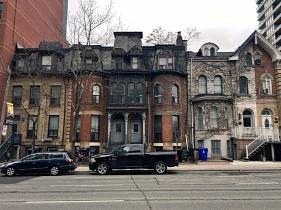Will we Ever Have Dirty Mansions Again?: Micallef
The signs of a dirty mansion are subtle: multiple hydro meters or a cluster of mailboxes by the front door are the tell-tale clues what was once a single family home has been divided up into apartments inside.
In a rather beautiful if melancholic Globe and Mail story last week on musicians leaving Toronto for cheaper Ontario cities, troubadour Corin Raymond, who has himself decamped to Hamilton, referred to these kinds of houses as “dirty mansions,†the first I’d heard them called that.
It’s such a brilliant term, not one meant to be taken literally or morally, but rather the house pride every house is anointed with, whether big or small, is undermined. Toronto has long had an apartment bias, where houses are valued above all, so the term “dirty mansion†has such a subversive edge to it, a bit of shade thrown towards a culture obsessed with aspirational home ownership.
I’ve lived in a few dirty mansions while in Toronto. The first, on Clinton near Dupont, was a basement apartment in the landlord’s house. It had a trap door with stairs in the ceiling we could pull in the event of a fire blocking our only door at the rear, allowing us to escape up through his living room. I never tested to see if it would work in fear I’d seem like I was snooping.
The second was truly a dirty mansion, a ramshackle row house on Dupont itself, backing onto the rail corridor. Ours was a shared three-bedroom apartment on the 2nd and 3rd floors, with other apartments tucked in on the 2nd, 1st, and basement levels. Like a lot of old houses on main streets, it looked battle-worn, almost fortified to protect itself from traffic and it bared its reverse-Frankenstein renovations on its facade. I never set foot in the back yard, an overgrown jungle of a place, but our kitchen was a strange carbuncle, created in a nook over the front porch that seemed to almost tilt over Dupont, with a little precarious deck on top of it that gave me vertigo.
This old house and thousands like it were carved up decades ago and were, for a long time, somewhat affordable places to live in the city. These kinds of quirky apartments are beloved by some people despite the walls being in weird places, dining rooms turned into bedrooms, and bathrooms under staircases, though they don’t get the same scorn condos do with their equally bad layouts. It’s remarkable how age and original wainscotting can play on our emotions.
Many Toronto neighbourhoods have gone through cycles from the original family homes to butchered apartments buildings, a shift that often happened during bad economic times or when the houses were out of fashion.
In Rosedale, many bona fide mansions were dirty mansions for a spell too, carved into apartments or rooming houses during the Depression and after the Second World War when the suburbs were the place to be. It is no coincidence that in the late 1940s, Mount Pleasant Rd. was created by bulldozing a path through the neighbourhood from Bloor up to St. Clair during this period. Though some apartment houses still exist, most have returned to their original form and it’s impossible to imagine Mt. Pleasant happening today in a neighbourhood that goes to war over a proposed switchback pathway into the Don Valley.
Neighbourhoods like Cabbagetown, Parkdale and the Annex are slowly being transformed from their apartment-rich period back into single family homes, reducing the amount of people neighbourhoods like these can absorb. Though less crowded than they once were, some folks in the Annex and its environs have vocally objected to the redevelopment of the Honest Ed’s site into rental apartments, even getting the number of dwelling units reduced from 1,017 to 806.
To get a sense of the reduction in human beings, the number of bedrooms on the site, across various apartment sizes, went from 1,595 to 1,224. That’s a lot less people who will get to rent a place in the Annex. Even in ostensibly the most “progressive†part of Toronto, sitting on a pile of real estate money will make people quite conservative and resistant to new neighbours.
So where will the next dirty mansions be? Should Toronto’s economy go sour — really sour — it could lead to a new wave of apartment conversions as people sell houses they can’t afford, but no one would ever wish economic calamity on the city.
This week the Star’s Jennifer Wells wrote a compelling column encouraging empty nester boomers living in large houses to subdivide and add an apartment or two. In North America, the spaces we live in have become oversized and Wells called for “more European-sized dwellingsâ€. Hey, that might even cut down on the hydro bills everybody complains about.
Geographically, the dirty mansions have always been in the older parts of Toronto, but why can’t the split-levels of the inner and outer suburbs split up too? Perhaps the McMansions of North Toronto could become Dirty McMansions. The potential for this apartment renaissance happening again is limited though because every neighbourhood seems to protest even town homes or lot splitting. Nobody wants new neighbours.
Noble dirty mansions, big Rosedale and Parkdale ones, or the crummy little subdivide shacks of humbler neighbourhoods, have played an important role in Toronto’s affordability and rental stock. It’s a shame they’re both disappearing and they’re not spreading to new neighbourhoods, and it’s a shame it took bad times to get the ones we still have.
Shawn Micallef writes every Saturday about where and how we live in the GTA. Wander the streets with him on Twitter @shawnmicallef
Comments
There are 0 comments on this post





